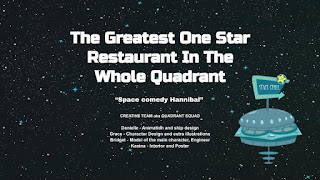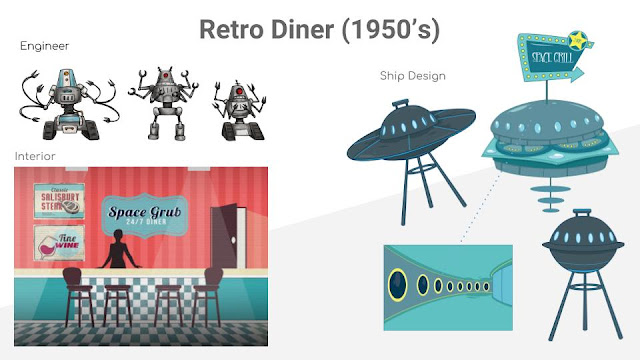Week 1
Phase One: Understanding Science Fiction, Stories, and Media
The first week consisted of each of us (we’re a group of 4) researching a movie or tv series based on short story or novel - or really just absorbing any sort of science fiction.
Kasina -
I looked into the movie ‘A.I Artificial Intelligence’ which I had never heard or watched before, but excited to look into it after Danielle recommended it. First off, it was sad. It reminded me of a modern take of Pinocchio but with much darker themes of AI, rejection, love, and loneliness.
A.I. Artificial Intelligence, is a 2001 sci-fi/ drama film directed by Steven Spielberg. It’s based on the short story "Supertoys Last All Summer Long" by Brian Aldiss written in 1969. The film originally began with director Stanley Kubrick before his death and then given to Spielberg to finish.
Context of story
A.I. is set in a futuristic post-climate change society. It tells a story of David, a child android programmed with the ability to love. He is adopted as a test case by a Cybernetic employee and his wife. After his adoptive parents abandon him, he then longs to become “real” so that he can get back the love of his human mother.
Original story to the screen
The story portrays the idea of an overpopulated world in which couples need permission from the government before having a child of their own. Despite the invention of robots who were designed to provide companionship, it is emphasized that one could still feel lonely and isolated, even in a world that is overpopulated. Having an artificial companion only seems to be a reminder of that continual loneliness.
In "Supertoys" David is three whereas in the movie he is older and artificial beings have already been around for years, whereas in the short story they seem to have been recently introduced.
The ending for me emphasizes the “human-ness” of the robots and questions the nature of what’s real and artificial. The interaction between David and the robots raises a few questions regarding possible ways to deal with the human race in the future, the risk of overpopulation, development of AI and isolation.
Design In the film
I was interested to see how the atmosphere throughout the film ranged from action/adventure to be extremely emotional which I thought was emphasised by the lighting and colours and used to reflect the screenplay. The cinematic aspect of the film reminded me of a lot of other popular sci-fi's, with the look of the distinct futuristic setting involving elaborate mechanical special effects, holograms, colourful lighting, cars, intricate makeups, etc. Much of the face and body makeup and special effects remind me of the android characters from 'Westworld', as well as the night design set of the exciting city space 'Rouge City' that looks similar to 'Blade Runner'.
Danielle -
Ghost in the Shell
1st slide: The Story
Speaker Notes:
which means cyborgs are now commonplace and the human brain is able to connect to the internet directly. In essence human consciousness has migrated into machines.
Puppet master was initially created as a tool to carry out covert diplomatic manipulation before he went rogue. He is able to hacks into the brains of cyborgs to obtain information
and commit crimes.
2nd slide: Movie Design
In a futuristic Japanese city, the visual cues suggest a rundown world, everything seems to be made of concrete, steel and neon lights giving it a cyberpunk dystopia vibe. A major theme in this movie is the dualism of humanity and technology.
It similarly mirrors how the protagonist views herself, although she has a human brain all of her body is made up of extensive bio-mechanical parts.
Grace -
Altered Carbon
For my research I looked into Altered Carbon, a 2018 Netflix TV show based on a 2002 novel by Richard K. Morgan.
Changes
Other changes included tweaks to the setting (Bancroft's mansion is a seaside place in the book, but in the sky in the TV show).
Character appearance - Bancroft's wife first shows up in tennis gear with a racket, and is described as looking 20 in the book, but is much older and wears flowing white robes in the show, likely to make her a more serious/intimidating character. Ortega is described as having show hair, and Bancroft with grey hair in a ponytail, both changed in the TV show.
Ortega gives Kovacs cigarettes, while in the TV show she was trying to make him (or the man who last inhabited his body) to quit (likely due to public opinion on cigarettes changing?).
Opinion
The first week consisted of each of us (we’re a group of 4) researching a movie or tv series based on short story or novel - or really just absorbing any sort of science fiction.
Kasina -
I looked into the movie ‘A.I Artificial Intelligence’ which I had never heard or watched before, but excited to look into it after Danielle recommended it. First off, it was sad. It reminded me of a modern take of Pinocchio but with much darker themes of AI, rejection, love, and loneliness.
A.I. Artificial Intelligence, is a 2001 sci-fi/ drama film directed by Steven Spielberg. It’s based on the short story "Supertoys Last All Summer Long" by Brian Aldiss written in 1969. The film originally began with director Stanley Kubrick before his death and then given to Spielberg to finish.
A.I. is set in a futuristic post-climate change society. It tells a story of David, a child android programmed with the ability to love. He is adopted as a test case by a Cybernetic employee and his wife. After his adoptive parents abandon him, he then longs to become “real” so that he can get back the love of his human mother.
Original story to the screen
The story portrays the idea of an overpopulated world in which couples need permission from the government before having a child of their own. Despite the invention of robots who were designed to provide companionship, it is emphasized that one could still feel lonely and isolated, even in a world that is overpopulated. Having an artificial companion only seems to be a reminder of that continual loneliness.
In "Supertoys" David is three whereas in the movie he is older and artificial beings have already been around for years, whereas in the short story they seem to have been recently introduced.
The ending for me emphasizes the “human-ness” of the robots and questions the nature of what’s real and artificial. The interaction between David and the robots raises a few questions regarding possible ways to deal with the human race in the future, the risk of overpopulation, development of AI and isolation.
Design In the film
I was interested to see how the atmosphere throughout the film ranged from action/adventure to be extremely emotional which I thought was emphasised by the lighting and colours and used to reflect the screenplay. The cinematic aspect of the film reminded me of a lot of other popular sci-fi's, with the look of the distinct futuristic setting involving elaborate mechanical special effects, holograms, colourful lighting, cars, intricate makeups, etc. Much of the face and body makeup and special effects remind me of the android characters from 'Westworld', as well as the night design set of the exciting city space 'Rouge City' that looks similar to 'Blade Runner'.
Danielle -
Ghost in the Shell
1st slide: The Story
Speaker Notes:
which means cyborgs are now commonplace and the human brain is able to connect to the internet directly. In essence human consciousness has migrated into machines.
Puppet master was initially created as a tool to carry out covert diplomatic manipulation before he went rogue. He is able to hacks into the brains of cyborgs to obtain information
and commit crimes.
2nd slide: Movie Design
Speaker Notes:
In a futuristic Japanese city, the visual cues suggest a rundown world, everything seems to be made of concrete, steel and neon lights giving it a cyberpunk dystopia vibe. A major theme in this movie is the dualism of humanity and technology.
It similarly mirrors how the protagonist views herself, although she has a human brain all of her body is made up of extensive bio-mechanical parts.
Grace -
Altered Carbon
For my research I looked into Altered Carbon, a 2018 Netflix TV show based on a 2002 novel by Richard K. Morgan.
Origin and since then
It was written at the turn of the millenium, during the dot-com bubble, at a time of technological advance. Since then, we have seen a further leap in technology (AI, digital interface, VR, etc.)Changes
Other changes included tweaks to the setting (Bancroft's mansion is a seaside place in the book, but in the sky in the TV show).
Character appearance - Bancroft's wife first shows up in tennis gear with a racket, and is described as looking 20 in the book, but is much older and wears flowing white robes in the show, likely to make her a more serious/intimidating character. Ortega is described as having show hair, and Bancroft with grey hair in a ponytail, both changed in the TV show.
Ortega gives Kovacs cigarettes, while in the TV show she was trying to make him (or the man who last inhabited his body) to quit (likely due to public opinion on cigarettes changing?).
No mention of Banfcroft's backup being attempted to hack, the fact someone thought shooting him would kill him is used to indicate it could not have been him or his wife in the book, while in the show it's mentioned during his first meeting with Kovacs.
Kovacs has no initial refusal to work for Bancroft, while he does in the TV show (likely so they could have a resolution at the end of the first ep where he changes his mind).
As the book is written in first person, scenes following other characters in the TV show were not present in it.
Opinion
I think overall it was a good show, and some changes were made for the better (although some perhaps not).
The premise is interesting, and the idea of stacks is something I could see people using far in the future. Visuals are good and the world feels believable. The acting is good, action good, no problem with the dialogue. Mystery keeps you interested. The pacing could have been improved in my opinion though.
Design used
Design elements are setting/environment, in world logos/advertisements, digital interface, costume design, weapon design, vehicle and other technology design, visuals for digital space.
Bridget -
Design used
Design elements are setting/environment, in world logos/advertisements, digital interface, costume design, weapon design, vehicle and other technology design, visuals for digital space.
Bridget -
Overlapping themes in the four movies:



















Comments
Post a Comment